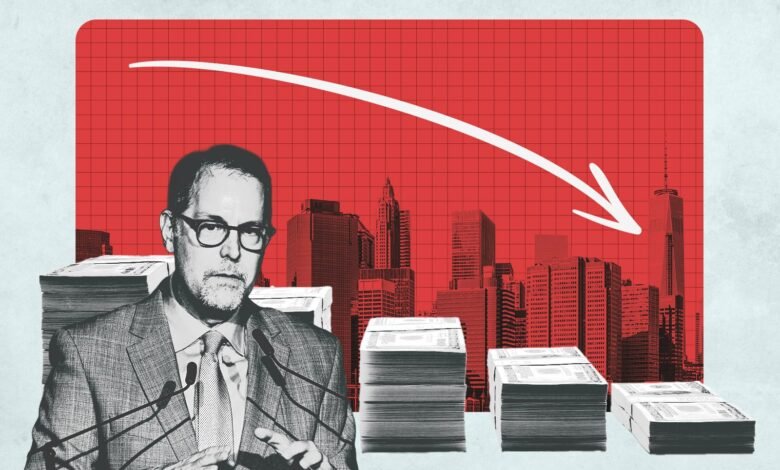Rent-stabilized Investments Drive NYC Pension Fund Losses

During the six years since New York’s rent law crushed rent-stabilized revenue, the industry opinion became almost unanimous: The legislation would be the death of much of the regulated housing stock.
But landlord anecdotes have now given way to court data on increased foreclosure filings and damning reports by watchdog groups and researchers, widening the consensus. Some say the problem is a time bomb: If the state doesn’t step in and alter the law, New York City will have to pick up the pieces of the coming explosion, whether it can afford to or not.
And yet, neither government has acknowledged the threat. Rather, electeds have flat-out denied the distressed narrative. Their doubt, perhaps, stemmed from their distance from the issue. Neither had been forced to shoulder the losses that landlords have.
Until now.
An analysis of city records by The Real Deal found that two city-managed pension funds that are invested in majority rent-stabilized housing — the subset most affected by the rent law’s revenue constraints — have cratered, losing more than two-thirds of their value since 2019. (A tweet in August tipped reporters off to the loss, and a Bisnow article earlier this month explained how the investment happened.)
Investments made in partnership with Related and Hudson, once worth $531 million, are now valued at $165 million, a 69 percent decrease.
Part of that drop emerged after buildings sold, many of them at a loss. But the values of properties still held by the funds have eroded, too.
Owner groups say the numbers are irrefutable evidence that the Housing Stability and Tenant Protection Act of 2019, which effectively capped revenue at rent-stabilized buildings, has driven outsized vacancies that are sending values into the ground — and also that politicians can no longer deny this.
“New York City’s own pension fund proves the damage of the 2019 rent laws,” Kenny Burgos, CEO of the New York Apartment Association, said. The NYAA represents owners of rent-stabilized housing.
The question is whether Albany or New York City, the latter now a victim of the law itself, will see the data for what it is before very bad turns to worse.
A good idea (at the time)
The rent-stabilized investments came out of Hurricane Sandy.
In 2013, then-Comptroller John Liu allocated $300 million and $200 million to affordable housing developers Related and Hudson, respectively, to finance housing repair and construction in the wake of Sandy’s $19 billion economic blow.
The money was an equity stake to secure an additional $1 billion in loans for Sandy-related construction or repair of about 3,000 affordable units — some rent-stabilized, some market rate. At the time, Crain’s New York Business reported that the city estimated that the funds would provide returns between 9 and 14 percent.
For a time, they more or less hit those marks.
The Related investment boasted an annualized net internal rate of return of 14.3 percent, pension performance reports from 2019 show. The Hudson investment in the same period posted an IRR of 8.6 percent.
But after the 2019 rent law passed, performance plummeted.
The investments’ multiples — another way to gauge value — slipped. In the quarter after the legislation went live, Related’s multiple dropped 30 percent to 1.14 from 1.63, and Hudson’s fell by about 9 percent to 1.16 from 1.27.
Fast forward to 2025: Related’s multiple now stands at 0.49, meaning the investment has lost over half its value; Hudson’s is 1.09.
The actual value may be even less than reported.
“You have to assume that they’re always overestimating,” John Murphy, who ran the city employees’ retirement system from 1990 to 2005, said. The retirement system is New York City’s largest pension fund.
Because there’s no open market for this type of real estate investment, the way there is for stocks, it’s impossible to know the value of these buildings until they sell.
It’s like trying to determine the value of a used car, Murphy said.
“When you don’t have an independent market to refer to, you get people’s guesses and they’re always biased,” he added.
The devil’s in the data
But a spate of recent sales now puts numbers and a visual to value declines.
In May of this year, rent-stabilized investors and frequent partners PH Realty and Rockledge purchased a portfolio of 34 rent-stabilized buildings in the Bronx from Related Fund Management, and by extension, from the pension funds.
PH, run by Hungerford, paid $192.5 million for the portfolio, 24 percent less than the $253 million the pension fund paid in 2014 (and that’s before accounting for the $30 million sunk into renovations).
Of the 2,020 units in the portfolio, 263 of them, or 13 percent, were vacant on closing, many because of their poor condition.
Collectively, the portfolio carried 3,105 housing code violations, 923 of which were designated immediately hazardous: roach and mouse infestations, lack of hot water, mold and lead paint.
“They were making deliberate business choices to leave units vacant instead of renting them,” Hungerford said. “That to me is just like, ‘Wow.’”
To be fair, the rent law likely wasn’t the only factor that drove the Related buildings into disrepair. Stubborn inflation, soaring insurance premiums, rising property taxes and water bills, and high interest rates have all pressured the business model. But the rent law made it impossible for many owners to raise rents enough to cover these increased costs.
Through a wider lens, a TRD analysis of property records found that 43 Related buildings bought with pension funds between 2014 and 2016 were later sold at a loss between 2023 and 2025.
The median haircut was 24 percent. One Bronx building sold at a near-60 percent loss.
These 43 properties represent only a portion of the pension fund’s investments; many are held under separate companies that are hard to track, and TRD’s analysis excludes buildings sold before 2019, many of which appreciated in value.
The Hudson investments are now generating a 1.4 percent return — effectively, peanuts — and the Related fund is operating at an 18.4 percent loss.
The difference between the returns underscores the severity of the rent-stabilized crisis.
Both investments are in workforce housing, meaning apartments that are priced to be affordable for residents below a certain percentage of the area median income.
According to a former official familiar with the investments, the Hudson investment was focused more on buildings directly in the Sandy flood zone. These buildings have a higher mix of market-rate units.
The Related portfolio was invested in a higher percentage of pure-play rent-stabilized buildings, and thus was more exposed to the asset class’s downturn.
Screaming into the void
The pension fund losses aren’t news to the industry. Rather, they support the vacancy data, sales numbers and on-the-ground anecdotes that landlords for years have begged the city to recognize as facts and figures that amount to a five-alarm fire.
Community Preservation Corporation, the nonprofit lender, recently reported eight times as many foreclosure filings against the 100 percent rent-stabilized buildings in its portfolio as in 2022. (The more rent-stabilized a building, the more constrained its revenues.)
Nearly 30 percent of CPC’s entirely rent-stabilized portfolio doesn’t rake in sufficient rent to cover debt service.
New York University’s Furman Center this spring found the cost of operating older, entirely rent-stabilized properties, particularly those in the Bronx, exceeded their rent rolls by an average of $1,444 annually in 2024.
Citizens Budget Commission, a watchdog, warned of an imminent “maintenance death spiral” if the city did not step in.
Confronted with those claims, the city has largely refused to acknowledge the pain. Instead, numerous council members, including Speaker Adrienne Adams, have repeatedly called on the Rent Guidelines Board, the body that approves annual rent adjustments for stabilized units, to minimize increases to protect tenants.
Zohran Mamdani, leading in the New York City mayoral race, is running on a rent freeze.
Comptroller Brad Lander, meanwhile, has refuted claims that the surge in rent-stabilized vacancies is a problem. In a 2024 report, the comptroller found “no evidence that the HSTPA led to an increase in vacancies, or distress on the city’s rent stabilized housing.”
The report went on to say proposals to allow landlords to deregulate units after vacancy are “a dramatic overreaction.”
The Community Housing Improvement Program, a trade association that’s now part of NYAA, had pushed for a so-called rent reset bill that would allow owners to boost rents to closer to affordability levels connected to area median income; but critically, those apartments would remain rent-stabilized.
Moving the needle?
It’s unlikely the pension data, though glaring, will compel electeds to listen.
A spokesperson for Lander’s office did not respond to questions about the losses in the report.
“As financial stewards of New York City’s five public pension funds, investing in rent-stabilized housing reflects our commitment to utilizing our pension systems to steadily deliver long-term risk-adjusted investment returns while preserving access to stable and affordable housing as our housing crisis grows more dire,” the spokesperson said.
To be sure, the city’s pension fund on the whole is humming along just fine. It beat expectations in fiscal year 2025, earning a 10.3 percent return across the five systems, well above the 7 percent benchmark, Lander recently announced. And the $500 million rent-stabilized investment is a tiny piece of the pension fund, which was valued at $294.6 billion in June.
That means the rent-stabilized stuff is no threat to city workers’ retirements.
Even faced with the numbers, the man who made the investment, then-comptroller Liu, has stood by the decision. Liu, a state senator who co-sponsored HSTPA, disputed the premise that rents aren’t keeping pace with costs.
“For every landlord that is facing financial hardship, there are still many more landlords that are doing just fine,” he said in an interview with TRD.
He did acknowledge that some owners were struggling but said there could be any number of causes, including the pandemic or the Rent Guidelines Board “not providing the rent increases that probably should have been granted.”
He underscored the law’s wins: that it rightly blocked bad actors from speculating on rent-stabilized apartments or buying portfolios with the hope of deregulating units to boost rents.
“Thank heaven we enacted the Tenant Protection Act in 2019 that reversed 20 years of a consistent pattern of apartment deregulation and people and families losing their homes,” Liu said.
Mark Levine, the Democratic nominee for comptroller and the current Manhattan Borough President has said that he wants to beef up pension investment in affordable housing. He proposed investing $2.5 billion from unallocated ETI funds to offer affordable financing to developers to create or preserve affordable units. In the plan, he called affordable housing development “an increasingly safe investment.”
His investments would be structured differently than Liu’s Sandy investments, mostly acting as mezzanine debt that could eventually be converted to equity. That financing would allow projects that are sitting in line for other discretionary financing options to receive funding faster, in exchange for developers improving their project’s affordability by either adding affordable units or making planned units more affordable.
He says that the investments would not be in the same kind of distressed, existing rent-regulated housing as the 2013 investment.
“We’re looking for that sweet spot where we have some certainty on a stable investment with regular returns, but also providing financing that might not otherwise be available to developers,” Levine said in an interview with TRD.
He acknowledged that these investments “may on average have a slightly lower return than more typical investments but they’re part of a broad portfolio and the pension fund has a really good track record of meeting its target of 7 percent returns on average over years.”
However it’s discussed, the numbers show that protections against potential profiteers have devalued rent-stabilized buildings.
Devaluation doesn’t necessarily reflect the physical condition of rent-stabilized buildings, sources say. It could reflect a market free from investors buying with the intent to deregulate, raise rents and value.
This, according to one former official, could be what the comptroller’s office is arguing when it considers the poor performance of the rent-stabilized pension investments, that the numbers might look alarming, but they’re just a natural reaction to long-term tenant protection.
Advocates and observers of the industry believe the city’s dismissal of the data is purely political.
“The politics is dictating the reaction to the rent law and its impact on the housing quality,” Jay Martin, an executive at NYAA, said.
That is: Even if the rent law is creating vacancies that kill property values, exacerbating the housing crisis and driving losses — albeit small — to city workers’ retirement accounts, electeds are not going to advocate for any change that would drive rents higher.
Tenants are their largest constituency, and tenants, as their advocates at every Rent Guidelines Board meeting this year have cried, are drowning, too.
To acknowledge the landlords’ plight would be a bad look, Sherwin Belkin, a rent-stabilized attorney, said.
“If they say, ‘We made a mistake,’ — and I think they made a whopper of a mistake by so many aspects of the 2019 law — that will lead to putting their re-election in jeopardy,” he said.
“And first and foremost is, ‘I want to stay in office.’”
Read more

Industry says report proves the 2019 rent law was “disastrous”

Rent-stabilized building sells for $285K — a 97% value cut

Foreclosures and delinquencies hitting affordable, nonprofit players




